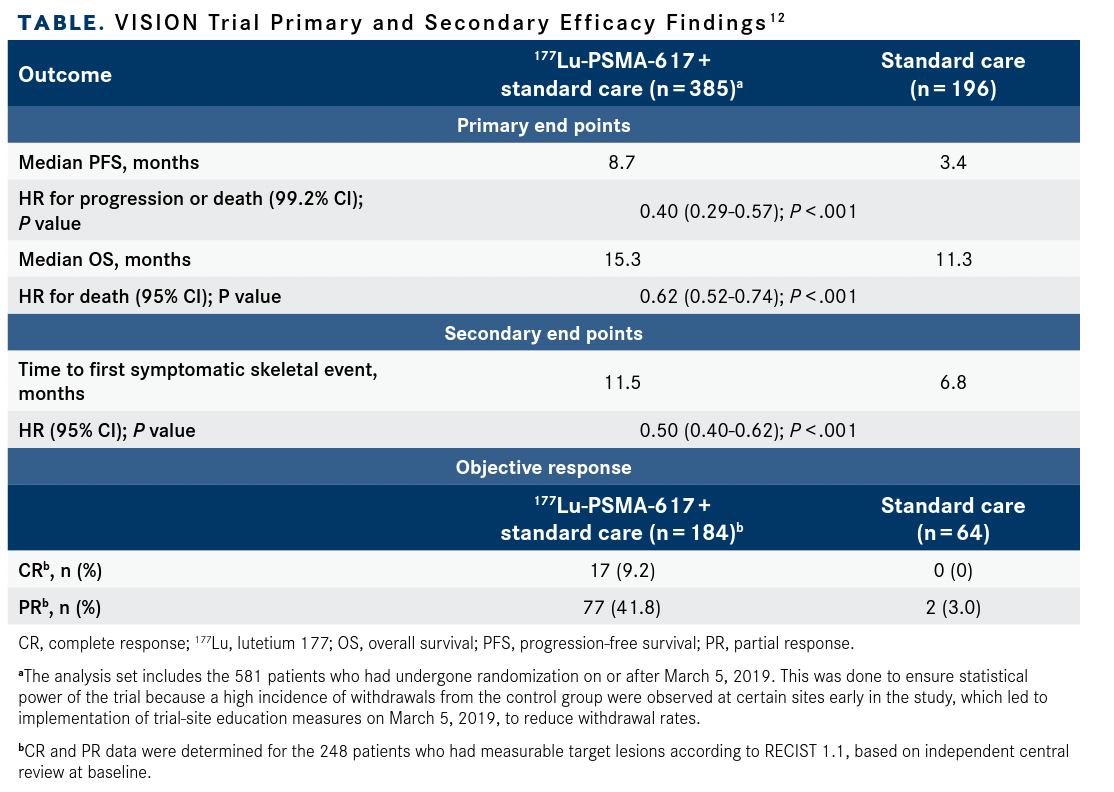A New Era of Precision Medicine Takes Shape in Prostate Cancer
Prostate cancer is a highly hetero-geneous disease, with individual tumor cells having distinct genomic and pheno-typic characteristics, resulting in a great deal of variability in patients’ disease course.
Sandy Srinivas, MD

Prostate cancer is a highly hetero-geneous disease, with individual tumor cells having distinct genomic and pheno-typic characteristics, resulting in a great deal of variability in patients’ disease course. Although some pros-tate cancers are slow growing and amenable to being safely monitored, others are more rapidly growing and aggressive, potentially proving fatal without prompt and effective inter-ventions. Subsequently, being able to precisely determine the nature of the disease is crucial to prevent overtreatment of more benign disease and undertreatment or subop-timal treatment of more aggressive disease, which can be fatal.
During a recent OncLive Peer Exchange®, a panel of prostate cancer experts discussed how precision medicine is helping ensure more patients with prostate cancer are appro-priately treated. They discussed newer diagnostic modalities, such as liquid tumor profiling, and examined the role of pros-tate-specific membrane antigen (PSMA) for diagnostic imaging and treatment via targeted radionuclides, which are ushering in a potentially new approach to prostate cancer management known as theranostics. “There’s such significant heterogeneity [in prostate cancer] that our ability to pick therapy for a given individual should be based on some selection, and that’s what preci-sion medicine means to me,” Sandy Srinivas, MD, said.
Using Genomic Markers to Put Precision Medicine into Practice
Precision medicine is not a novel concept in the treatment of pros-tate cancer. “Precision medicine goes back to the time of ADT [androgen deprivation ther-apy] because targeting the androgen receptor (AR) was one of the very first precise ways of targeting cancer,” Alicia K. Morgans, MD, MPH, said. Although ADT remains the backbone of treat-ment for this patient population, a variety of other actionable targets have emerged in recent years, including BRCA2 mutations and tumor mutational burden or micro-satellite instability (MSI), which can be targeted with PARP inhibitors and pembrolizumab (Keytruda), respectively.
Alicia K. Morgans, MD, MPH

The challenge with these actionable targets, however, is that relatively few patients with prostate cancer have them. In studies assessing the frequency of BRCA mutations, the prevalence of germline or somatic BRCA2 mutations in prostate cancer has ranged from 5.3% to 13%.1 MSI-high tumors are even less common, with investiga-tors reporting an incidence of this actionable target in only 3.1% of patients.2
“I haven’t yet [encountered] a patient [with prostate cancer] who has MSI-high [disease],” Srinivas said, adding that she looks for this marker in patients with advanced disease who require treatment after AR therapy and are not good candi-dates for chemotherapy. “It’s at that point that I’ve definitely looked at prior tissue and liquid biopsies…. That’s a time to look for these mark-ers because the patients who have this will have such an amazing therapeutic option, one where they could have a response that could be more long lasting.”
The panelists noted several challenges when it comes to characterizing prostate cancer via tissue or blood sampling, as many patients have bone metastases but no accessible lymph nodes or visceral metastases that can be readily biopsied and sequenced. Subsequently, it can be particularly challenging identifying actionable somatic mutations. “Optimally, for any given patient, it’s best to use a plethora of different tools,” Scott T. Tagawa, MD, MS, said, explaining that each option has advantages that can help provide a more complete picture of the tumor profile for a particular patient.
Scott T. Tagawa, MD, MS

Tagawa noted that bone biopsies are often overlooked as an option but can be a valuable source for high-quality DNA and RNA for tumor sequencing that may be used to detect actionable alterations and resistance mechanisms in patients with bone metastases. In a bone biopsy study he was involved with, the material obtained via bone biopsy successfully confirmed prostate cancer in 85.7% of cases (n = 60/70 bone biopsies), with whole-exome sequencing possible in 81.7% of cases and RNA sequencing possible in 33.3% of cases.3 Recurrent alterations known to occur in prostate cancer were observed, including AR mutation (4.0%), PTEN deletion (10.2%), TP53 mutation (14.3%), BRCA2 mutation (10.2%), and SPOP mutation (4.0%).3
Although tissue biopsy is still considered the gold standard for identifying actionable genetic markers and providing the most in-depth information, Tagawa explained that the heterogeneity of prostate cancer poses challenges. “We get a great depth of whatever is in the needle, and that’s it. The same tumor in a different location may be a little different,” he said, adding that as a result, blood-based biomarkers can be a useful adjunct for obtaining information about tumors, provided the patient does not have a hematologic malignancy attributed to a germline mutation. With blood-based biomarkers, however, there are differences between circulating tumor DNA and cell-free DNA, he noted. “Circulating tumor DNA, where we have a germline-matched sample, is very good. It’s not as sensitive, but we can really trust those results. When we have cell-free DNA without a germline sample, we have to worry about clonal hematopoiesis.”
Morgans agreed and emphasized the importance of germline testing. “All patients with advanced prostate cancer, high-risk localized or metastatic hormone-sensitive and beyond, are eligible for germline testing at this point in time. They’re not just eligible—it’s recommended,” she said.
Moving Toward Phenotypic Markers in Prostate Cancer: PSMA
Phenotypic biomarkers are an emerging area in cancer medicine. Unlike genetic markers that include mutations and other cellular aberrations, phenotypic biomarkers are f indings that can be detected on the cell, usually via an imaging study. These findings can help predict prognosis and responsiveness to therapy. One phenotypic biomarker that is already changing the prostate cancer landscape is PSMA, with 2 PSMA-targeted diagnostic agents recently receiving FDA approval and opening the door for patients to be treated with PSMA-targeted molecules. “A lot of times, the focus has been on detecting disease, but now the idea of using imaging to select patients for treatment is real,” Phillip J. Koo, MD, said.
Phillip J. Koo, MD

PSMA is a transmembrane protein with 100- to 1000-fold higher expression by prostate cancer cells than normal prostate cells.4 Although PSMA expression has been observed in almost all types of prostate cancer, expression is highest in adenocarcinomas. Expression also increases progressively in higher-grade disease, metastatic disease, and castration-resistant prostate cancer (CRPC), suggesting PSMA may play a role in the identification of prostate cancer progression.5,6
“Close to 85% of patients with advanced disease have positive PSMA expression, “ Srinivas said. “As [patients] get more treatment, perhaps with AR-directed therapy, there’s increased expression of PSMA.” For example, study results showed a median 45% increase in intensity of PSMA standard uptake value was by day 9 of treatment with ADT.7
The 2 FDA-approved PSMA-targeted diagnostic agents are gallium 68 (68GA)PSMA-11, which was approved in December 2020, and DCFPyL F 18 (Pylarify), a fluorine 18–based PyL approved in May.8,9 The approval of 18F-DCFPyL is particularly notable because it is enabling PSMA imaging to become available nationwide. In contrast, access to 68GA PSMA-11 has been limited to the University of California in San Francisco and Los Angeles. “We’re seeing nationwide commercialization of the PyL compound because of the isotope, which allows it to be distributed across the United States pretty easily. This is going to really change what we see in terms of access,” Koo said.
Approval of 18F-DCFPyL as a positron emission tomography (PET)/CT agent was based on data from 2 studies: OSPREY (NCT02981368) and CONDOR (NCT03739684).10,11
OSPREY trial
In the phase 2/3 OSPREY trial, 2 patient populations underwent 18F-DCFPyL PET/CT scanning: cohort A, which included men with high-risk prostate cancer undergoing radical prostatectomy with pelvic lymphadenectomy (n = 252), and cohort B, which included men with suspected recurrent/metastatic prostate cancer on conventional imaging (n = 93).10 All scans were evaluated by 3 blinded central readers, with the scans’ diagnostic performance determined by comparing the imaging results with the histopathology findings.
In cohort A, 18F-DCFPyL PET/CT had a median specificity of 97.9% and median sensitivity of 40.3%, the latter of which did not meet the prespecified end point. The median positive predictive value was 86.7% and the median negative predictive value was 83.2%. In cohort B (median prostate-specific antigen [PSA], 11.3 ng/mL), the median sensitivity and positive predictive value for extraprostatic lesions were 95.8% and 81.9%, respectively.
CONDOR trial
In the phase 3 CONDOR trial, 208 men with rising PSA at least 0.2 ng/mL after prostatectomy or at least 2 ng/mL above nadir after radiotherapy (median baseline PSA, 0.8 ng/mL; range, 0.2-98.4 ng/mL) underwent 18F-DCFPyL PET/CT scanning.11 The primary end point was the correct localization rate (CLR), which was defined as positive predic-tive value with an additional requirement of anatomic lesion colocalization between 18F-DCFPyL-PET/CT and a composite stan-dard of truth (ie, histopathology, subsequent correlative imaging findings, or postradia-tion PSA response). The trial was deemed successful if the lower bound of the 95% CI for CLR was greater than 20% for 2 of the 3 central readers of the scans. Secondary end points included change in intended manage-ment and safety.
The CLR was 84.8% to 87.0%, with the lower bound of the 95% CI being 77.8% to 80.4%. The disease detection rate was 59% to 66% (≥ 1 lesion detected per patient via scan-ning by central readers). Following scanning, 63.9% of evaluable patients had a change in intended management.
“It’s important for our patients to under-stand where the value of this test would be,” Srinivas said. “The biggest thing I see in my practice is patients with biochemical recur-rence with the lowest PSA who can do salvage radiation or metastatic-directed therapy. To me, that’s the biggest value that PSMA brings to the field.”
PSMA-targeted PET/CT practical considerations
Tagawa noted that PSMA-targeted imaging currently has 3 key uses in clinical practice: (1) deciding on initial treatments, as it can help identify sites of disease outside the pros-tate; (2) helping to determine where elevated PSA levels are coming from; and (3) enabling optimization of treatment for patients with metastatic disease by opening the door to use of PSMA-targeted radionuclide therapy. He explained that although there are some clear differences in radiochemistry between the 2 FDA-approved imaging agents, these differ-ences do not really matter for the end user because the data for the 2 agents have shown similar findings. “When compared with the microscope, each one was approximately 40%. But when we look at the larger results, in terms of true positivity, then we’re looking at 95% to 98%,” he said.
Koo agreed with Tagawa that PSMA PET/CT scanning does not replace a microscope. “A lot of times I see PSMA PET equated to identifying micrometastatic disease, and that’s not true,” he said. “It cannot identify micrometastatic disease. By definition these are things that we’re detecting with a micro-scope, pathology, and tissue. That’s important because it sheds light on the limitations of this imaging modality.”
Morgans also pointed out that PSMA-based imaging can only identify PSMA-positive disease. “Some disease can sometimes be FDG [fluorodeoxyglucose] avid but not PSMA avid,” she said, emphasizing the importance of explaining this to patients so that they are not under the false impression that PSMA PET/CT imaging will pick up any cancer they have. Despite its limitations, Morgans said that “any PSMA PET imaging that [patients] can undergo is great.”
Progress in Developing Theranostics
“I heard a talk once that [described] our abil-ity to target PSMA with imaging as a light bulb and our ability to target it with ther-anostics as a little bomb—and to think about PSMA being utilized in both ways, allowing us to image our patients poten-tially more sensitively or accurately, as well as potentially [delivering treatment] to them,” Morgans said.
Although no PSMA-based treatments have yet been approved by the FDA, the radiopharmaceutical lutetium 177 (177Lu)–PSMA-617 has recently been shown to improve progression-free survival (PFS) and overall survival (OS) in men with meta-static CRPC enrolled in the VISION trial (NCT03511664).12 All patients in the trial (N = 831) were previously treated with at least 1 AR-pathway inhibitor and 1 or 2 taxane regimens; thus, this is a popula-tion with few remaining treatment options and great unmet need.12 PSMA positiv-ity was required for inclusion in the study and was determined via 68GA PSMA-11 PET/CT scanning.
177Lu-PSMA-617 is a radioligand designed to deliver β-particle radiation to PSMA-expressing cells and their surrounding microenvironment. In the VISION trial, patients were randomly assigned 2:1 to receive 177Lu-PSMA-617 (7.4 GBq every 6 weeks for 4-6 cycles) plus protocol-permit-ted standard care (n = 551) or standard care alone (n = 280). Protocol-permitted standard of care did not allow use of chemotherapy, immunotherapy, radium-223 dichloride (Xofigo), or investigational drugs.
After a median follow-up of 20.9 months, PSMA-directed radiotherapy plus the standard of care significantly prolonged imaging-based PFS and OS vs standard care alone (TABLE).12 Additionally, the key secondary endpoints, including time to symptomatic skeletal events and objective response, favored the addition of 177Lu-PSMA-617.
TABLE. VISION Trial Primary and Secondary Efficacy Findings

“The disappointing part was that the overall effect was not as huge as what we might have wanted. But it was in keeping with all of the drugs that we have had in the CRPC space, with an absolute improvement in the ballpark of around 4.5 to 5 months, which is what we have seen with drugs such as abiraterone acetate [Zytiga] and enzalutamide [Xtandi],” Srinivas said, adding that she hopes that 177Lu-PSMA-617 will move to earlier lines because it may have a larger role there. “[VISION] was a positive trial, bringing a new class of drugs to our patients with CRPC, but we are awaiting the FDA label to see what the indication will be.”
The incidence of adverse effects (AEs) grade 3 or higher was more prevalent in the 177Lu-PSMA-617 arm vs the standardof-care arm, occurring in 52.7% and 38.0% of patients, respectively. The most common AEs with PSMA-directed treatment included fatigue, dry mouth, nausea, and anemia, with most of these being grade 1 or 2. Five AEs that led to death were attributed to 177Lu-PSMA-617: pancytopenia (n = 2), bone marrow failure (n = 1), subdural hematoma (n = 1), and intracranial hemorrhage (n = 1).
“Overall, it’s very well tolerated…better tolerated than chemotherapy in a head-tohead setting, except for a few items, such as dry mouth and thrombocytopenia,” Tagawa said, referring to the AEs observed in the TheraP trial (NCT03392428).13 In this study, grade 3 to 4 AEs occurred in 32 of 98 men (33%) in the 177Lu-PSMA-617 arm vs 45 of 85 men (53%) in the cabazitaxel (Jevtana) arm. No deaths were attributed to 177Lu-PSMA-617.
Tagawa noted that several 177Lu-PSMA-617 trials are ongoing and recruiting patients, including those in earlier treatment settings. “I think many more patients, particularly those who are lucky to have it locally or are able to travel a little bit, will have opportunities to receive 177Lu-PSMA-617,” he said.
References
- Messina C, Cattrini C, Soldato D, et al. BRCA mutations in prostate cancer: prognostic and predictive implications. J Oncol. 2020;2020:4986365. doi:10.1155/2020/4986365
- Abida W, Cheng ML, Armenia J, et al. Analysis of the prevalence of microsatellite instability in prostate cancer and response to immune checkpoint blockade. JAMA Oncol. 2019;5(4):471-478. doi:10.1001/jamaoncol.2018.5801
- Sailer V, Schiffman MH, Kossai M, et al. Bone biopsy protocol for advanced prostate cancer in the era of precision medicine. Cancer. 2018;124(5):1008-1015. doi:10.1002/cncr.31173
- Ristau BT, O’Keefe DS, Bacich DJ. The prostate-specific membrane antigen: lessons and current clinical implications from 20 years of research. Urol Oncol. 2014;32(3):272-279. doi:10.1016/j. urolonc.2013.09.003
- Sweat SD, Pacelli A, Murphy GP, Bostwick DG. Prostate-specific membrane antigen expression is greatest in prostate adenocarcinoma and lymph node metastases. Urology. 1998;52(4):637-640. doi:10.1016/s0090-4295(98)00278-7
- Tagawa ST, Beltran H, Vallabhajosula S, et al. Anti-prostate-specific membrane antigen-based radioimmunotherapy for prostate cancer. Cancer. 2010;116 (suppl 4):1075-1083. doi:10.1002/ cncr.24795
- Emmett L, Yin C, Crumbaker M, et al. Rapid modulation of PSMA expression by androgen deprivation: serial 68Ga-PSMA-11 PET in men with hormone-sensitive and castrate-resistant prostate cancer commencing androgen blockade. J Nucl Med. 2019;60(7):950954. doi:10.2967/jnumed.118.223099
- FDA approves first PSMA-targeted PET imaging drug for men with prostate cancer. News release.
- FDA. December 1, 2020. Accessed September 27, 2021. bit.ly/2Y5r3SE FDA approves second PSMA-targeted PET imaging drug for men with prostate cancer. News release. FDA. Updated May 27, 2021. Accessed September 27, 2021. bit.ly/2ZFt9ZV
- Pienta KJ, Gorin MA, Rowe SP, et al. A phase 2/3 prospective multicenter study of the diagnostic accuracy of prostate specific membrane antigen PET/CT with 18F-DCFPyL in prostate cancer patients (OSPREY). J Urol. 2021;206(1):52-61. doi:10.1097/ JU.0000000000001698
- Morris MJ, Rowe SP, Gorin MA, et al; CONDOR Study Group. Diagnostic performance of 18F-DCFPyL-PET/CT in men with biochemically recurrent prostate cancer: results from the CONDOR phase III, multicenter study. Clin Cancer Res. 2021;27(13):36743682. doi:10.1158/1078-0432.CCR-20-4573
- Sartor O, de Bono J, Chi KN, et al; VISION Investigators. Lutetium-177-PSMA-617 for metastatic castration-resistant prostate cancer. N Engl J Med. 2021;385(12):1091-1103. doi:10.1056/ NEJMoa2107322
- Hofman MS, Emmett L, Sandhu S, et al; TheraP Trial Investigators and the Australian and New Zealand Urogenital and Prostate Cancer Trials Group. [177Lu]Lu-PSMA-617 versus cabazitaxel in patients with metastatic castration-resistant prostate cancer (TheraP): a randomised, open-label, phase 2 trial. Lancet. 2021;397(10276):797804. doi:10.1016/S0140-6736(21)00237-3




